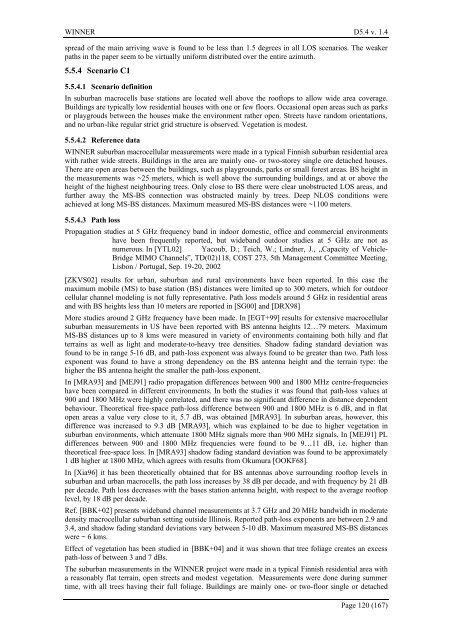Final report on link level and system level channel models - Winner
Final report on link level and system level channel models - Winner
Final report on link level and system level channel models - Winner
Create successful ePaper yourself
Turn your PDF publications into a flip-book with our unique Google optimized e-Paper software.
WINNER D5.4 v. 1.4<br />
spread of the main arriving wave is found to be less than 1.5 degrees in all LOS scenarios. The weaker<br />
paths in the paper seem to be virtually uniform distributed over the entire azimuth.<br />
5.5.4 Scenario C1<br />
5.5.4.1 Scenario definiti<strong>on</strong><br />
In suburban macrocells base stati<strong>on</strong>s are located well above the rooftops to allow wide area coverage.<br />
Buildings are typically low residential houses with <strong>on</strong>e or few floors. Occasi<strong>on</strong>al open areas such as parks<br />
or playgrouds between the houses make the envir<strong>on</strong>ment rather open. Streets have r<strong>and</strong>om orientati<strong>on</strong>s,<br />
<strong>and</strong> no urban-like regular strict grid structure is observed. Vegetati<strong>on</strong> is modest.<br />
5.5.4.2 Reference data<br />
WINNER suburban macrocellular measurements were made in a typical Finnish suburban residential area<br />
with rather wide streets. Buildings in the area are mainly <strong>on</strong>e- or two-storey single ore detached houses.<br />
There are open areas between the buildings, such as playgrounds, parks or small forest areas. BS height in<br />
the measurements was ~25 meters, which is well above the surrounding buildings, <strong>and</strong> at or above the<br />
height of the highest neighbouring trees. Only close to BS there were clear unobstructed LOS areas, <strong>and</strong><br />
further away the MS-BS c<strong>on</strong>necti<strong>on</strong> was obstructed mainly by trees. Deep NLOS c<strong>on</strong>diti<strong>on</strong>s were<br />
achieved at l<strong>on</strong>g MS-BS distances. Maximum measured MS-BS distances were ~1100 meters.<br />
5.5.4.3 Path loss<br />
Propagati<strong>on</strong> studies at 5 GHz frequency b<strong>and</strong> in indoor domestic, office <strong>and</strong> commercial envir<strong>on</strong>ments<br />
have been frequently <str<strong>on</strong>g>report</str<strong>on</strong>g>ed, but wideb<strong>and</strong> outdoor studies at 5 GHz are not as<br />
numerous. In [YTL02] Yacoub, D.; Teich, W.; Lindner, J., „Capacity of Vehicle-<br />
Bridge MIMO Channels”, TD(02)118, COST 273, 5th Management Committee Meeting,<br />
Lisb<strong>on</strong> / Portugal, Sep. 19-20, 2002<br />
[ZKVS02] results for urban, suburban <strong>and</strong> rural envir<strong>on</strong>ments have been <str<strong>on</strong>g>report</str<strong>on</strong>g>ed. In this case the<br />
maximum mobile (MS) to base stati<strong>on</strong> (BS) distances were limited up to 300 meters, which for outdoor<br />
cellular <strong>channel</strong> modeling is not fully representative. Path loss <strong>models</strong> around 5 GHz in residential areas<br />
<strong>and</strong> with BS heights less than 10 meters are <str<strong>on</strong>g>report</str<strong>on</strong>g>ed in [SG00] <strong>and</strong> [DRX98]<br />
More studies around 2 GHz frequency have been made. In [EGT+99] results for extensive macrocellular<br />
suburban measurements in US have been <str<strong>on</strong>g>report</str<strong>on</strong>g>ed with BS antenna heights 12…79 meters. Maximum<br />
MS-BS distances up to 8 kms were measured in variety of envir<strong>on</strong>ments c<strong>on</strong>taining both hilly <strong>and</strong> flat<br />
terrains as well as light <strong>and</strong> moderate-to-heavy tree densities. Shadow fading st<strong>and</strong>ard deviati<strong>on</strong> was<br />
found to be in range 5-16 dB, <strong>and</strong> path-loss exp<strong>on</strong>ent was always found to be greater than two. Path loss<br />
exp<strong>on</strong>ent was found to have a str<strong>on</strong>g dependency <strong>on</strong> the BS antenna height <strong>and</strong> the terrain type: the<br />
higher the BS antenna height the smaller the path-loss exp<strong>on</strong>ent.<br />
In [MRA93] <strong>and</strong> [MEJ91] radio propagati<strong>on</strong> differences between 900 <strong>and</strong> 1800 MHz centre-frequencies<br />
have been compared in different envir<strong>on</strong>ments. In both the studies it was found that path-loss values at<br />
900 <strong>and</strong> 1800 MHz were highly correlated, <strong>and</strong> there was no significant difference in distance dependent<br />
behaviour. Theoretical free-space path-loss difference between 900 <strong>and</strong> 1800 MHz is 6 dB, <strong>and</strong> in flat<br />
open areas a value very close to it, 5.7 dB, was obtained [MRA93]. In suburban areas, however, this<br />
difference was increased to 9.3 dB [MRA93], which was explained to be due to higher vegetati<strong>on</strong> in<br />
suburban envir<strong>on</strong>ments, which attenuate 1800 MHz signals more than 900 MHz signals. In [MEJ91] PL<br />
differences between 900 <strong>and</strong> 1800 MHz frequencies were found to be 9…11 dB, i.e. higher than<br />
theoretical free-space loss. In [MRA93] shadow fading st<strong>and</strong>ard deviati<strong>on</strong> was found to be approximately<br />
1 dB higher at 1800 MHz, which agrees with results from Okumura [OOKF68].<br />
In [Xia96] it has been theoretically obtained that for BS antennas above surrounding rooftop <strong>level</strong>s in<br />
suburban <strong>and</strong> urban macrocells, the path loss increases by 38 dB per decade, <strong>and</strong> with frequency by 21 dB<br />
per decade. Path loss decreases with the bases stati<strong>on</strong> antenna height, with respect to the average rooftop<br />
<strong>level</strong>, by 18 dB per decade.<br />
Ref. [BBK+02] presents wideb<strong>and</strong> <strong>channel</strong> measurements at 3.7 GHz <strong>and</strong> 20 MHz b<strong>and</strong>widh in moderate<br />
density macrocellular suburban setting outside Illinois. Reported path-loss exp<strong>on</strong>ents are between 2.9 <strong>and</strong><br />
3.4, <strong>and</strong> shadow fading st<strong>and</strong>ard deviati<strong>on</strong>s vary between 5-10 dB. Maximum measured MS-BS distances<br />
were ~ 6 kms.<br />
Effect of vegetati<strong>on</strong> has been studied in [BBK+04] <strong>and</strong> it was shown that tree foliage creates an excess<br />
path-loss of between 3 <strong>and</strong> 7 dBs.<br />
The suburban measurements in the WINNER project were made in a typical Finnish residential area with<br />
a reas<strong>on</strong>ably flat terrain, open streets <strong>and</strong> modest vegetati<strong>on</strong>. Measurements were d<strong>on</strong>e during summer<br />
time, with all trees having their full foliage. Buildings are mainly <strong>on</strong>e- or two-floor single or detached<br />
Page 120 (167)

















